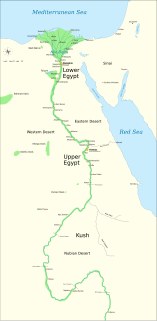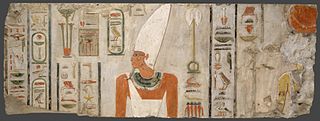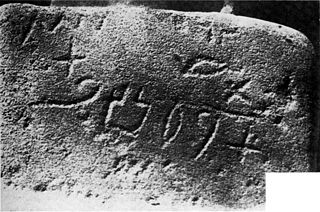Related Research Articles

Amenemhat III, also known as Amenemhet III, was a pharaoh of ancient Egypt and the sixth king of the Twelfth Dynasty of the Middle Kingdom. He was elevated to throne as co-regent by his father Senusret III, with whom he shared the throne as the active king for twenty years. During his reign, Egypt attained its cultural and economic zenith of the Middle Kingdom.

The First Intermediate Period, described as a 'dark period' in ancient Egyptian history, spanned approximately 125 years, c. 2181–2055 BC, after the end of the Old Kingdom. It comprises the Seventh, Eighth, Ninth, Tenth, and part of the Eleventh Dynasties. The concept of a "First Intermediate Period" was coined in 1926 by Egyptologists Georg Steindorff and Henri Frankfort.

The Eleventh Dynasty of ancient Egypt is a well-attested group of rulers. Its earlier members before Pharaoh Mentuhotep II are grouped with the four preceding dynasties to form the First Intermediate Period, whereas the later members are considered part of the Middle Kingdom. They all ruled from Thebes in Upper Egypt.

Hannu, Hennu or Henenu was an Egyptian noble, serving as m-r-pr "majordomo" to Mentuhotep III in the 20th century BC. He reportedly re-opened the trade routes to Punt and Libya for the Middle Kingdom of Egypt. He was buried in a tomb in Deir el-Bahri, in the Theban Necropolis, which has been catalogued as TT313.

Mentuhotep II, also known under his prenomen Nebhepetre, was an ancient Egyptian pharaoh, the sixth ruler of the Eleventh Dynasty. He is credited with reuniting Egypt, thus ending the turbulent First Intermediate Period and becoming the first pharaoh of the Middle Kingdom. He reigned for 51 years, according to the Turin King List. Mentuhotep II succeeded his father Intef III on the throne and was in turn succeeded by his son Mentuhotep III.

Sehertawy Intef I was a local nomarch at Thebes during the early First Intermediate Period and the first member of the 11th Dynasty to lay claim to a Horus name. Intef reigned from 4 to 16 years c. 2120 BC or c. 2070 BC during which time he probably waged war with his northern neighbor, the Coptite nomarch Tjauti. Intef was buried in a saff tomb at El-Tarif, known today as Saff el-Dawaba.
Intef III was the third pharaoh of the Eleventh Dynasty of Egypt during the late First Intermediate Period in the 21st century BC, at a time when Egypt was divided in two kingdoms. The son of his predecessor Intef II and father of his successor Mentuhotep II, Intef III reigned for 8 years over Upper Egypt and extended his domain North against the 10th Dynasty state, perhaps as far north as the 17th nome. He undertook some building activity on Elephantine. Intef III is buried in a large saff tomb at El-Tarif known as Saff el-Barqa.

Proto-Sinaitic is considered the earliest trace of alphabetic writing and the common ancestor of both the Ancient South Arabian script and the Phoenician alphabet, which led to many modern alphabets including the Greek alphabet. According to common theory, Canaanites or Hyksos who spoke a Semitic language repurposed Egyptian hieroglyphs to construct a different script. The script is attested in a small corpus of inscriptions found at Serabit el-Khadim in the Sinai Peninsula, Egypt, dating to the Middle Bronze Age.

Senusret I also anglicized as Sesostris I and Senwosret I, was the second pharaoh of the Twelfth Dynasty of Egypt. He ruled from 1971 BC to 1926 BC, and was one of the most powerful kings of this Dynasty. He was the son of Amenemhat I. Senusret I was known by his prenomen, Kheperkare, which means "the Ka of Re is created." He expanded Egypt that allowed him to rule over an age of prosperity.

Gebel el-Silsila or Gebel Silsileh is 65 km (40 mi) north of Aswan in Upper Egypt, where the cliffs on both sides close to the narrowest point along the length of the entire Nile. The location is between Edfu in the north towards Lower Egypt and Kom Ombo in the south towards Upper Egypt. The name Kheny means "The Place of Rowing". It was used as a major quarry site on both sides of the Nile from at least the 18th Dynasty to Greco-Roman times. Silsila is famous for its New Kingdom stelai and cenotaphs.
The year 1999 in archaeology involved some significant events.

El-Tarif is a necropolis on the West Bank of the Nile, at the site of ancient Thebes (Luxor), Egypt. It is located in the northwestern outskirts of Luxor and southeast of the Valley of the Kings, opposite Karnak, just to the southwest of the modern village of At-Tarif. It is the oldest of West Thebes' necropolises. It is a small mortuary temple, and the farthest north of the Tombs of the Nobles, and contains tombs of the late First Intermediate Period, Second Intermediate Period and early Middle Kingdom. Old Kingdom mastabas are possibly attributed to local rulers of the Fourth or Fifth Dynasty. Eleventh Dynasty tombs of local rulers have also been noted in the form of a series of rock-cut tombs dated to 2061-2010 B.C.E, the largest of which are Intef I to Intef III, who were kings of this dynasty.

Nubkheperre Intef was an Egyptian king of the Seventeenth Dynasty of Egypt at Thebes during the Second Intermediate Period, when Egypt was divided by rival dynasties including the Hyksos in Lower Egypt.

Sekhemre Wadjkhaw Sobekemsaf I was a pharaoh of Egypt during the 17th Dynasty. He is attested by a series of inscriptions mentioning a mining expedition to the rock quarries at Wadi Hammamat in the Eastern Desert during his reign. One of the inscriptions is explicitly dated to his Year 7. He also extensively restored and decorated the Temple of Monthu at Medamud where a fine relief of this king making an offering before the gods has survived.

Sekhemre-Wepmaat Intef was an Egyptian king of the Seventeenth Dynasty of Egypt, who lived late during the Second Intermediate Period, when Egypt was divided into two by Hyksos controlled Lower Egypt and Theban ruled Upper Egypt.

The stone quarries of ancient Egypt once produced quality stone for the construction of decorative monuments such as sculptures and obelisks. These quarries are now recognised archaeological sites. Eighty percent of the ancient quarry sites are in the Nile valley; some of them have disappeared under the waters of Lake Nasser and some others were lost due to modern mining activity.

Wadi Hammamat is a dry river bed in Egypt's Eastern Desert, about halfway between Al-Qusayr and Qena. It was a major mining region and trade route east from the Nile Valley in ancient times, and three thousand years of rock carvings and graffiti make it a major scientific and tourist site today.

Wadi el-Hol is a valley on the Farshut Road, north-west of Luxor on the Qena Bend, situated on the west bank of the river Nile in Egypt. Rock inscriptions in the valley appear to show the oldest examples of phonetic alphabetic writing discovered to date.
The Theban Desert Road Survey is an archaeological research project operated in conjunction with the Egyptian Ministry of Culture's Supreme Council for Antiquities that is being conducted in the Western Desert in Egypt that focuses on the ancient connections between Thebes and such settlements as the Kharga Oasis. The project uses remote sensing to identify roads and caravan trails that were used in antiquity to identify possible sites of previously unknown communities. Established in 1991 by Egyptologists Deborah Darnell and her then-husband John Coleman Darnell, the survey project grew substantially when it gained the support of Yale University in 1998. The Theban Desert Road Survey has discovered sites from Predynastic Egypt, including substantial caches of pottery and other artifacts.
Tjauti was an ancient Egyptian official who lived at the end of the Eighth Dynasty, around 2150 BC. He is known from a number of sources providing evidence that he was an important figure in the Coptic Nome in Upper Egypt. However, the sources are often broken and the figure of Tjauti remains therefore enigmatic. The most important objects naming Tjauti are the fragments of a false door found near Khozam where he is called overseer of Upper Egypt, which was one of the most important titles in the Old Kingdom. He is also called the one who fills the heart of the king showing some close connection to the royal court. A person called Tjauti-iqer also appears in several inscriptions in the Wadi Hammamat, reporting the transport of stones: Tjauti-iqer seems to be a variant of the name. The inscriptions also mentions the god's father Idy, who was the son of Shemay. Shemay lived at the end of the Eighth Dynasty providing also a date for Tjauti to about the same period.
References
- ↑ "Theban Desert Road Survey in the Egyptian Western Desert, Volume 1: Gebel Tjauti Rock Inscriptions 1-45 and Wadi el-Hôl Rock Inscriptions 1-45 | The Oriental Institute of the University of Chicago". oi.uchicago.edu. Retrieved 2022-06-20.
- ↑ Maha Farid Mostafa: The Mastaba of SmAj at Naga' Kom el-Koffar, Qift. Band I: Autobiographies and related scenes and texts. Ministry of Antiquities and Heritage, Cairo 2014, ISBN 978-977642004-5, 200-201
- ↑ John C. Darnell: Theban Desert Road Survey in the Egyptian Western Desert, Vol. 1, Gebel Tjauti Rock Inscriptions 1-45 and Wadi el-Hol Rock Inscriptions 1-45, Chicago 2002, ISBN 1-885923-17-1, p. 30-46